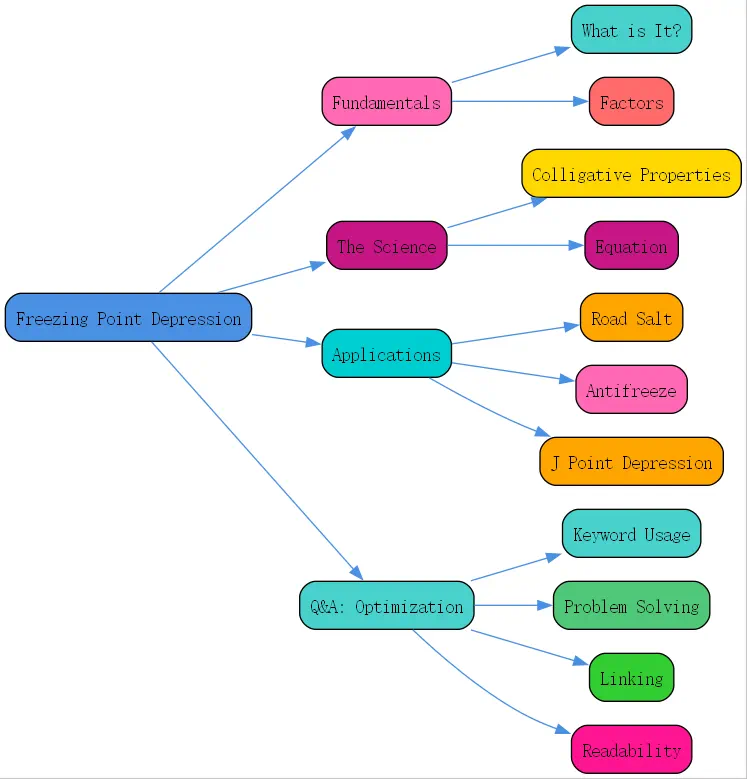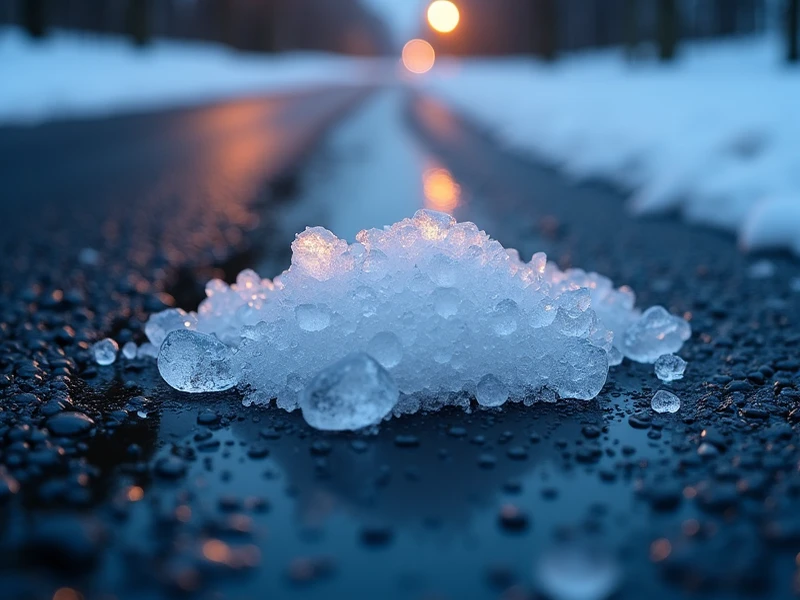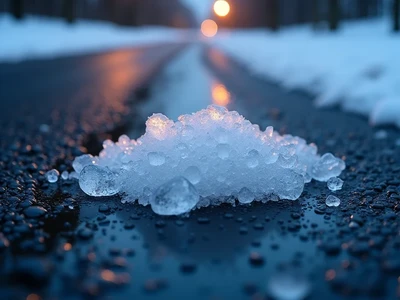At BrainTalking, we love breaking down complex topics into bite-sized, understandable pieces. Today, we’re diving into freezing point depression—a cool scientific concept that’s more relevant to your life than you might think. Whether it’s keeping roads ice-free or ensuring your car runs in winter, this phenomenon is everywhere. In this guide, we’ll explore what freezing point depression is, the science behind it, and how it’s applied in practical ways, all while connecting it to everyday insights.
Freezing Point Depression: Understanding the Fundamentals

What is Freezing Point Depression?
Freezing point depression happens when a solute—like salt or sugar—is added to a solvent, lowering its freezing point. This means the solution stays liquid at a colder temperature than the pure solvent would. It’s a colligative property, so it depends on the number of solute particles, not their type. At its core, this process disrupts the solvent’s ability to form solid crystals, keeping it fluid longer.

Think about icy roads in winter. Cities sprinkle salt to melt ice because it lowers water’s freezing point, turning slippery surfaces into safer ones. Another example? Antifreeze in your car’s radiator keeps the coolant from freezing, even in subzero temps. Even making ice cream uses this trick—adding salt to ice creates a colder mix to freeze the cream faster.
This concept isn’t just practical—it’s a window into how solutions behave. Chemists use freezing point depression to figure out molecular weights, measuring how much a solute shifts the freezing point. It’s a simple idea with big impacts, from kitchens to labs.
Factors Affecting Freezing Point Depression
So, what makes freezing point depression tick? Two big factors: solute concentration and the solvent itself. Let’s unpack these.
First, concentration is king. The more solute particles you add, the lower the freezing point drops. Picture salt on a road: a light dusting might not cut it, but a heavy layer melts ice fast. This happens because more particles interfere with the solvent’s freezing process, pushing the freeze point down further. It’s why a concentrated sugar syrup stays liquid longer in the cold than plain water.
Second, the solvent matters. Water’s a common example, freezing at 0°C, but solvents like ethanol or benzene have different starting points and responses. Each has a unique cryoscopic constant—a number that shows how much its freezing point shifts per unit of solute. Water’s constant is 1.86 °C kg/mol, so it’s predictable, but swap the solvent, and the game changes.
The solute’s behavior counts too. Salt splits into ions, doubling its effect compared to sugar, which stays whole. These factors shape how freezing point depression works in real scenarios.
The Science Behind Freezing Point Depression
Colligative Properties Explained
Freezing point depression is part of a family called colligative properties—fancy traits of solutions tied to particle counts, not identities. Other siblings include boiling point elevation (think salty water boiling hotter) and osmotic pressure (why cells swell in pure water). They all hinge on how many solute bits are floating around, messing with the solvent’s normal behavior.
Here’s the gist: adding solute dilutes the solvent’s focus. In pure water, molecules lock into ice easily. Toss in salt, and those molecules get distracted, needing a colder temp to solidify. It’s like a party where extra guests slow down the cleanup—more particles, more chaos. This ties freezing point depression to everyday chemistry, from cooking to car care.
The Freezing Point Depression Equation
Want to predict this shift? There’s a formula for that:
[Delta T_f = i cdot K_f cdot m]
Breaking it down: (Delta T_f) is the freezing point drop. The van’t Hoff factor ((i)) is how many particles a solute splits into—1 for sugar, 2 for NaCl. (K_f) is the solvent’s cryoscopic constant (1.86 for water), and (m) is molality—moles of solute per kilogram of solvent. Simple, right?
Say you dissolve 1 mole of salt in 1 kg of water. With (i = 2), (K_f = 1.86), and (m = 1), the freezing point drops 3.72 °C—to -3.72 °C. Sugar, with (i = 1), only drops it 1.86 °C. This equation powers everything from antifreeze recipes to lab experiments, giving precision to the process.
Applications of Freezing Point Depression
Road Salt and Ice Removal
Ever wonder why roads get salty in winter? Salt lowers water’s freezing point, melting ice and preventing new freeze-ups. A sprinkle can drop the freezing point to -9 °C or lower, depending on concentration. It’s a lifesaver for drivers, keeping roads passable when temps plummet.
But it’s not all rosy. Salt runoff can pollute rivers, harm plants, and rust cars. In 2025, cities are testing greener options like beet juice or calcium magnesium acetate, which still depress the freezing point but with less environmental baggage. It’s a balance of safety and sustainability we’re still tweaking.
Antifreeze in Car Radiators
Your car’s radiator relies on freezing point depression too. Antifreeze—usually ethylene glycol—mixes with water to keep the coolant liquid in freezing weather. A 50/50 mix can push the freezing point down to -37 °C, protecting your engine from cracking in the cold.
Ethylene glycol’s cheap and effective but toxic. Propylene glycol’s a safer bet, though pricier. Either way, the right mix is key—too little, and you’re iced up; too much, and it’s overkill. It’s a perfect example of freezing point depression keeping us moving.
J Point Depression: A Related Medical Perspective
Now, let’s pivot to “J point depression”—a term from ECG readings, not solutions. On a heart monitor, the J point marks where the QRS complex meets the ST segment. J point depression, a dip below baseline, can signal issues like ischemia or hypothermia. It’s not about solutes, but the “depression” idea echoes our theme—something’s lowered from normal.
Tying this to antidepressants from pharmacology, both fields demand careful monitoring. Antidepressants like SSRIs can shift mood—sometimes dangerously—much like solutes shift freezing points. Patients need education on slow effects and risks, just as chemists need precision with solutions.

Speaking of meds, freezing point depression matters in pharma too. Some drugs, including antidepressants, need stable storage temps. Understanding the freezing point of depression in liquid formulations ensures they don’t freeze or degrade, keeping them safe and effective.
Connecting Pharmacology Insights
At BrainTalking, we see parallels everywhere. Antidepressants, per Nurse Mike’s wisdom, carry risks like suicide spikes in young adults (18-24) early on—energy rises before mood does. It’s a slow onset, needing weeks to work, and abrupt stops are a no-go. Mixing SSRIs with St. John’s Wort? That’s a serotonin syndrome risk, like mixing solutes carelessly alters freezing points. Safety’s the thread—monitor, taper, educate.

- Freezing point depression depends on solute concentration and solvent type.
- It’s behind road salt, antifreeze, and even drug stability.
- Watch for gradual effects and safety risks, in science and medicine alike.
Q&A: Optimizing Content for Keywords Like “”Freezing Point Depression””
Q: How can I optimize my content for keywords like “freezing point depression”?
A: Great question! Here’s how:
- Use Keywords Smartly: Slip “freezing point depression” into your title, meta description, and headers. Sprinkle in “freezing point of depression” and “freezing depression point” naturally—aim for 2-3 uses each.
- Solve Problems: Answer what readers want—how it works, why it matters. Google loves helpful content.
- Link Up: Add internal links to related posts (like Colligative Properties Explained) and external ones (like Chemistry Basics).
- Keep It Readable: Short sentences, clear headers, no stuffing—think 1-2% keyword density.
This boosts rankings and keeps readers hooked.
In wrapping up, freezing point depression isn’t just lab talk—it’s in your driveway, your freezer, even your medicine cabinet. From salt melting ice to antidepressants needing careful handling, it’s a concept with reach. We at BrainTalking hope you’ve enjoyed this dive into science made simple. Stick around for more—your curious mind deserves it!



